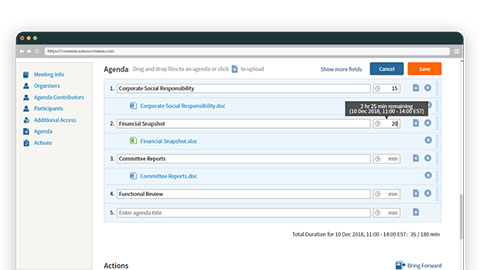Board meetings run an organization. Though infrequent, a board meeting is where board members take the opportunity to discuss critical matters and, more importantly, make decisions that will affect an organization in its entirety. That level of decision-making is a heavy and crucial responsibility for everyone involved but with that responsibility comes also a significant amount of authority – the kind that can be easily manipulated to discreetly impose personal interests. Alongside this is also the possibility of committing grave errors during the decision-making itself. With these risks in mind, a solution designed to keep both decisions and decision-makers in check was imposed: the quorum.
A quorum of the board is the minimum number of voting members or directors required to be present in a board meeting before business may be conducted. Organizations usually have bylaws in place that dictate the required quorum for their board, but if they don’t, the general fallback is as simple as going with the majority number. For example, if an organization has a board of five members and its bylaws don’t state the required quorum, the organization can choose three as the minimum number of attendees.
But what if the meeting has only two attendees while a third member sends an email that mentions their stand in several agenda items instead? Unfortunately, that can’t be considered as meeting a quorum. Sending in a proxy won’t do the trick either since the main point of having a quorum is to have enough authority present to make real-time decisions while keeping personal agendas from overtaking the organization’s interest and well-being.
A quorum is set for the good of an organization and everyone involved, but it has a certain level of infamy among board committees and administrators despite its well-intentioned purpose. Why? Because as a general rule, any business transacted will be considered invalid if a board meeting doesn’t meet the set quorum.
This has caused grief for many board committees and administrators, especially since not meeting the quorum is a common occurrence in many organizations. While there are remedies available such as taking recess or adjusting the time for adjournment, these are only temporary alternatives designed to buy enough time to gather or wait for enough members to satisfy the quorum.
Like all problems, the issue of not being able to satisfy a quorum must be dealt with at the root, focusing on why the quorum isn’t being met instead of what should be done when it happens. There are plenty of factors that affect a board’s attendance, poor or otherwise, but here are a few of the most common ones:
Time for the Quorum
The Problem:
When it comes to time, the problem can stem from two possibilities: The time set for meetings is always inconvenient for most board members or the length of the meeting is so long that it becomes counterproductive. Either way, it can be discouraging for attendees.
The Solution:
Adopt a system that can easily cross-check board members’ schedules to secure a slot where most – if not all – of them are free. Next, send meeting materials ahead of time, at least three days before the meeting; this will let them acquaint themselves with the important details beforehand. A board meeting is usually long since it has to make up for its infrequency but you can certainly make the discussion more bearable and productive. By allowing the participants to get acquainted with the agenda before an actual meeting, general information can be quickly taken off the table and more time can be allotted to crucial decision-making.
Awareness of Quorum
The Problem:
How can members attend a meeting they aren’t even aware of in the first place? Inefficient means of disseminating information can cause board members to miss out on or misinterpret important documents, including the invitation to the meeting itself. Sometimes, though it happens less often than missing an invitation, board members can’t attend meetings simply because they and their executive assistants forget. Given their hectic schedules, it isn’t unheard of for meetings to be buried underneath other matters of importance.
The Solution:
Establish efficient systems in place when it comes to distributing information. If the traditional means of delivery is no longer reliable, it would be wise to consider technology-based solutions. Administrators and organizers must also remember to check all the important documents for an upcoming meeting and send out reminders so that all board members are made aware of both the meeting’s schedule and agenda.
Leadership and Relevance Needed for Quorums
The Problem:
Considering board meetings only happen a couple of times a year and its participants are some of the organization’s busiest members, it’s only proper that the matters on the agenda are relevant and engaging. A common mistake is focusing too much on background and for-your-information matters instead of moving on to agenda items that need decision-making discussions. Consistent poor time management and agenda content can discourage participants from prioritizing such board meetings.
The Solution:
The chairperson’s part must be aware of the meeting’s direction and act accordingly if the discussion fails to tackle the important matters at hand. Participants, on the other hand, also need to cross-check the items on the agenda so that they can request to remove less important topics to the beginning of the meeting.
The Quorum
The Problem:
If management has exhausted every possible means to improve a board meeting’s attendance, it’s likely that the quorum itself is the problem. When it had been set, it probably wasn’t a realistic target. The quorum must involve enough authority to be valid, but a large quorum doesn’t necessarily mean better. If a board has 12 members and the quorum set was 11, then that board should consider themselves lucky if they’re able to hold a successful meeting once a year.
A change of quorum, however, must always be considered last since it has potential to be the lazy way out. It’s easy to skip all other possibilities and just go straight to making the system work for you. That path, while convenient, would likely have unfortunate consequences on the integrity and quality of the board’s decisions later on. Other factors and means must be taken into account before turning to the readjustment of a quorum.
The Solution:
When setting the quorum quotient, choose a number high enough to produce effective action points but low enough to be met by the average number of attendees.
Establishing a quorum is hard work but meeting it is even more so. Still, it’s important to remember why it exists in the first place. A quorum is there to ensure equal representation of an organization’s interests and to conduct proper review of any major decision. At the end of the day, the rewards of quorum compliance are worth the pains taken to achieve it.
—
Meeting the quorum is essential especially for any kind of meeting that involves decision-making regarding the board and the company. This includes a quorum needed for every board and shareholder meetings.
To ensure that when a board meets there is a quorum present, a digital solution can be used such as a board management software and virtual AGM solution to take note of attendance and expected quorum for both board meetings and annual general meetings respectively.
Tanecia is a current Chief Governance Officer at Convene with former experience working as a Cybersecurity Manager. She is a renowned advisor when it comes to corporate governance, board oversight, resource allocation, and risk management plans for organizations. In her work, she also helps shed light on strategies that can be done to ensure effective governance, while minimizing overall regulatory risk in the company’s cybersecurity projects.











